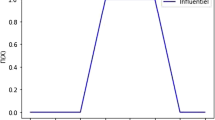Abstract
The popularity and the great success of social networks are due to their ability to offer Internet users a free space for expression where they can produce a large amount of information. Thus the new challenges of information research and data mining are to extract and analyze this mass of information which can then be used in different applications. This information is characterized mainly by incompleteness, imprecision, and heterogeneity. Indeed the task of analysis using models based on statistics and word frequencies is crucial. To solve the problem of uncertainty, the possibility theory turns out to be the most adequate. In this article, we propose a new approach to find relevant short texts such as tweets using the dual possibility and necessity. Our goal is to translate the fact that a tweet can only be relevant if there is not only a semantic relationship between the tweet and the query but also a synergy between the terms of the tweet. We have modeled the problem through a possibility network to measure the possibility of the relevance of terms in relation to a concept of a given query and a necessity network to measure the representativeness of terms in a tweet. The evaluation shows that using the theory of possibilities with a set of concepts relevant to an initial query gives the best precision rate compared to other approaches.
Access this chapter
Tax calculation will be finalised at checkout
Purchases are for personal use only
Similar content being viewed by others
References
Alam, F., Joty, S., Imran, M.: Domain adaptation with adversarial training and graph embeddings (2018)
Bouadjenek, M.R., Hacid, H., Bouzeghoub, M.: Social networks and information retrieval, how are they converging? a survey, a taxonomy and an analysis of social information retrieval approaches and platforms. Inf. Syst. 56, 1–18 (2016)
Crayston, T.: Textrazor: Technology
Duan, Y., Jiang, L., Qin, T., Zhou, M., Shum, H.Y.: An empirical study on learning to rank of tweets. In: Proceedings of the 23rd International Conference on Computational Linguistics, pp. 295–303. Association for Computational Linguistics (2010)
Goldberg, Y., Levy, O.: word2vec explained: deriving mikolov et al’.s negative-sampling word-embedding method. arXiv preprint arXiv:1402.3722 (2014)
Ji, S., Yun, H., Yanardag, P., Matsushima, S., Vishwanathan, S.: WordRank: learning word embeddings via robust ranking. arXiv preprint arXiv:1506.02761 (2015)
Kirsch, S.M.: Social information retrieval (2005)
Lin, Y., Li, Y., Xu, W., Guo, J.: Microblog retrieval based on term similarity graph. In: Proceedings of 2012 2nd International Conference on Computer Science and Network Technology, pp. 1322–1325, December 2012. https://doi.org/10.1109-ICCSNT.2012.6526165
Nguyen, H.V., Bai, L.: Cosine similarity metric learning for face verification. In: Kimmel, R., Klette, R., Sugimoto, A. (eds.) ACCV 2010. LNCS, vol. 6493, pp. 709–720. Springer, Heidelberg (2011). https://doi.org/10.1007/978-3-642-19309-5_55
Robertson, S.E., Jones, K.S.: Relevance weighting of search terms. J. Am. Soc. Inf. Sci. 27(3), 129–146 (1976)
Salton, G., Wong, A., Yang, C.S.: A vector space model for automatic indexing. Commun. ACM 18(11), 613–620 (1975). https://doi.org/10.1145/361219.361220
Sendi, M., Omri, M.N., Abed, M.: Possibilistic interest discovery from uncertain information in social networks. Intell. Data Anal. 21(6), 1425–1442 (2017)
Ferguson, P., O’Hare, N., Lanagan, J., Phelan, O., McCarthy, K.: An investigation of term weighting approaches for microblog retrieval. In: Baeza-Yates, R., et al. (eds.) ECIR 2012. LNCS, vol. 7224, pp. 552–555. Springer, Heidelberg (2012). https://doi.org/10.1007/978-3-642-28997-2_62
Massoudi, K., Tsagkias, M., de Rijke, M., Weerkamp, W.: Incorporating query expansion and quality indicators in searching microblog posts. In: Clough, P., et al. (eds.) ECIR 2011. LNCS, vol. 6611, pp. 362–367. Springer, Heidelberg (2011). https://doi.org/10.1007/978-3-642-20161-5_36
Boughanem, M., Brini, A., Dubois, D.: Possibilistic networks for information retrieval. Int. J. Approximate Reasoning 50(7), 957–968 (2009)
Brini, A.H., Boughanem, M., Dubois, D.: A model for information retrieval based on possibilistic networks. In: Consens, M., Navarro, G. (eds.) SPIRE 2005. LNCS, vol. 3772, pp. 271–282. Springer, Heidelberg (2005). https://doi.org/10.1007/11575832_31
Author information
Authors and Affiliations
Corresponding author
Editor information
Editors and Affiliations
Rights and permissions
Copyright information
© 2020 Springer Nature Switzerland AG
About this paper
Cite this paper
Meriem, A.B., Hlaoua, L., Romdhane, L.B. (2020). Tweet Relevance Based on the Theory of Possibility. In: Yang, H., Pasupa, K., Leung, A.CS., Kwok, J.T., Chan, J.H., King, I. (eds) Neural Information Processing. ICONIP 2020. Communications in Computer and Information Science, vol 1332. Springer, Cham. https://doi.org/10.1007/978-3-030-63820-7_17
Download citation
DOI: https://doi.org/10.1007/978-3-030-63820-7_17
Published:
Publisher Name: Springer, Cham
Print ISBN: 978-3-030-63819-1
Online ISBN: 978-3-030-63820-7
eBook Packages: Computer ScienceComputer Science (R0)




